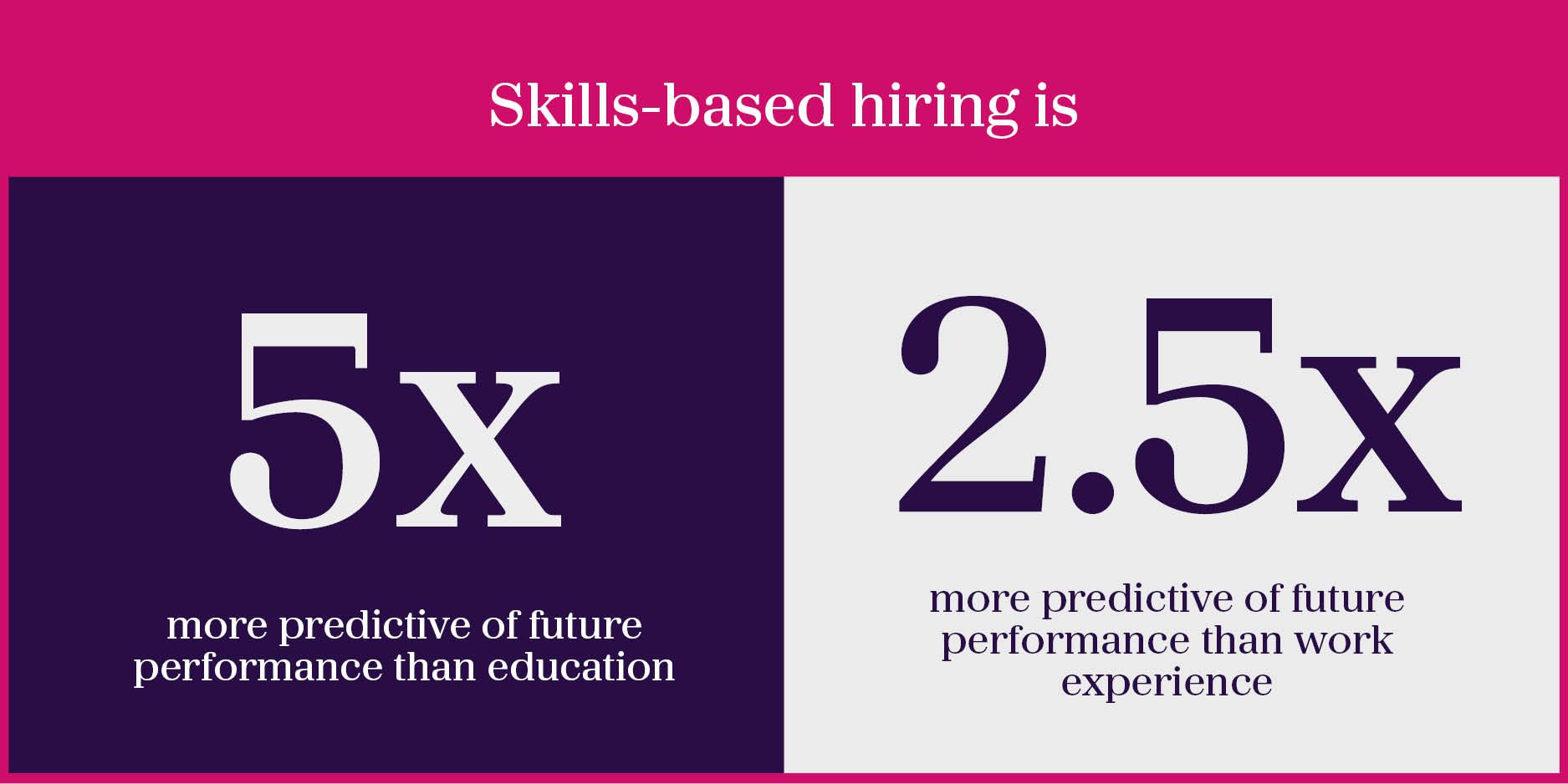The rise of
skills-based hiring
Contributors
Jo-Ann Feely
Global Managing Director, Innovation, AMS

The era of fixed job roles, linear promotions and rigid functions is over. Modern workplaces are agile, flexible and able to pivot to new strategies, ideas and challenges to deal with a volatile, changeable environment.
Driven by this new reality - and accelerated by the impact of the pandemic - many organizations are moving away from recruiting on experience and qualification to skills-based hiring for potential and flexibility.
Of course, talent shortages and technological needs are affecting this move too. According to Dell Technologies, more than 85% of jobs that will exist in the next decade haven’t even been invented yet. In the face of such uncertainty, an individual’s past experience is less relevant than the skills they hold and can acquire in the future.
Skills as the new currency
One advocate of the move towards skills-based hiring is LinkedIn CEO Ryan Roslansky.
“Our data shows that roles are being created and displaced at a truly record pace right now. Whatever your role, whatever your company, whatever your industry, you need to keep up with these really quick and big changes that are going on right now,” argued Roslansky in a podcast with Harvard Business Review.
Traditionally, business leaders and hiring managers have focused on past experience, qualifications, universities or personal networks as a way of assessing talent. Not only does this narrow talent pools and lessen diversity, but it also no longer makes sense when the pace of change is so rapid, says Roslanksy.
“If you take the same job role from 2015 to 2022 that existed in the world, roughly 25% of the skills needed for that job will have changed. When the labor market is moving much quicker, we really need something to focus on. I think that alternative, flexible, accessible path is really going to be based on skills,” he adds.
Take a systemic approach
Jo-Ann Feely is global managing director, innovation at AMS. She agrees with Roslansky that organizations are under pressure to find more sustainable ways to deal with talent scarcity.
“I think organizations are being forced to look inwards because they’ve really struggled to fill vacancies in the external market. The speed to digitization, especially post-pandemic, has put a lot of pressure on the skills needed to do roles as almost all organizations became digital ones,” she says.
In order for businesses to move towards skills-based hiring, they need to better understand the skills their current workforce have, alongside the different skills each job role requires.
“There needs to be a systemic approach to understanding skills. To make career mobility effective and skills-based hiring work, you need to understand the primary and secondary skills needed to do each job,” says Feely.
The challenge for business is two-fold. Firstly, they need to have some way of categorizing the skills they require - such as skills taxonomy - which takes time and effort to build and update. Secondly, there needs to be a culture shift in hiring away from instant gratification (i.e. poaching a job-ready employee from a competitor) towards looking to new hires or existing employees with skills adjacent abilities that can be developed through training.
“Skills-based hiring isn’t going to be an organizational, wholesale change. It’s going to take pilots within certain functions or departments, as it’s not an easy thing to effect,” says Feely.
“If you want to identify adjacent skills, you need to understand and map out the skills required for the roles you need. Doing this exercise is time-consuming, but on the positive side it not only increases career mobility, but it also allows for a broader talent pool externally,” she adds.

More inclusive workforces
Increasingly, hiring managers and talent professionals are starting to agree. In the US, major employers like Walmart, Boeing and IBM have signed up to skills-based hiring projects through partnerships with social mobility champions like Rework America Alliance. In Maryland, the local government announced in 2022 that it would no longer require college degrees for 50% of its state jobs.
However, the pace of change is slow. In the previously discussed Harvard Business School podcast, Roslansky described how LinkedIn data saw the potential for food service employees to be retrained as digital customer service workers during the pandemic. According to the data, there is a 70% match between the skills of the two roles. Yet many roles went unfilled and people lost jobs because organizations focused on past experience rather than skills.
“If we had just taken a view on what skills are necessary, who had those skills, how can we help them acquire some skills to become employed, we would’ve found ourselves in a much more efficient labor market. We would have been much more productive,” he said.
When it comes to talent attraction, skills-based hiring is also a better indicator of future success. Studies show that skills-based hiring is five times more predictive of future performance than hiring for education, and 2.5 times more predictive than past work experience.

The rise of skills-based hiring means organizations can better prepare for future challenges, develop internal career mobility and build their employee skill base. It can also lead to a more inclusive, equitable work environment.
“If you take a skills-based approach, you can open a broader talent pool both internally and externally. You can also identify under-represented talent that hasn’t come to the surface before because you’ve always hired a certain profile of person from a certain background or education,” says Feely.
“This approach to hiring broadens the talent pool and makes an organization more inclusive with a more equal playing field. Skills are the new currency. We just need to see organizations embrace it faster,” she adds.
written by the Catalyst Editorial Board
with contribution from:

Jo-Ann Feely
Global Managing Director, Innovation, AMS


